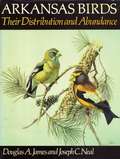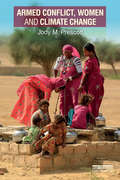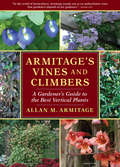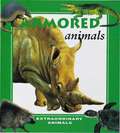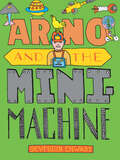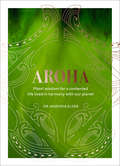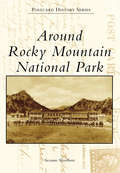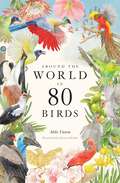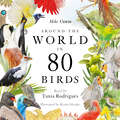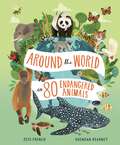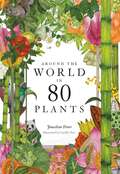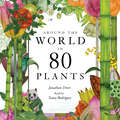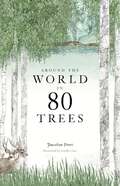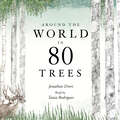- Table View
- List View
Arizona: The Grand Canyon State
by Mark LiskBeautiful coffee-table book featuring photography from across the state of Arizona.
Ark on the Move
by Gerald DurrellDurrell dramatically reveals the plight of endangered species and shows us the serious consequences to life and its future on this earth. The islands of Mauritius and Madagascar provide the exotic setting for Durrell's most recent expedition.
Arkansas Birds: Their Distribution and Abundance
by Douglas A. James Joseph C. NealThis edition has an in-depth reference work on Arkansas birds. It includes interesting quotations from 19th -century ornithologists and nature historians as well as evidence from more recent research.
Arlo Finch in the Valley of Fire (Arlo Finch #1)
by John AugustArlo Finch in the Valley of Fire is the first book in a spellbinding fantasy adventure series by screenwriter John August.Some trails lead to magic. Some lead to danger. As Arlo looked around, the walls of his room began to vanish, revealing a moonlit forest. Only his bed remained, and the frame of his window, through which he saw the girl. The world on her side of the glass was sparkling with silver and gold, like a palace made of autumn leaves. She looked off to her right. Someone was coming. Her words came in an urgent whisper: "If I can see you, they can see you . . . Be careful, Arlo Finch.” Arlo Finch thought becoming a Ranger meant learning wilderness skills, like camping and knots. But upon arriving in the tiny town of Pine Mountain, Colorado, Arlo soon learns there's so much more. His new friends Indra and Wu teach him how to harness the wild magic seeping in from the mysterious Long Woods—a parallel realm of wonder and danger.First he must master the basics, including snaplights, thunderclaps and identifying supernatural creatures. But Arlo Finch is no ordinary Ranger, and this is no ordinary time. A dark and ancient force is sending threats into the real world . . . our world.Through perilous adventures and close calls, Arlo is awakened to his unique destiny—but the obstacles he faces will test the foundations of the Ranger's Vow: loyalty, bravery, kindness, and truth.A Junior Library Guild selection
Armada's Wake (Jack Stannard of the Navy Royal)
by J. D. DaviesThe beacons are lit – the Armada is sighted off the English coast. The thrilling final instalment of the Navy Royal trilogy.1588: The greatest naval force of its age bears down upon England. As a devastating battle looms, a nation holds its breath.Jack Stannard, grandson of the original Jack, is stationed on Drake’s warship Revenge. His father, Tom, commands his own vessel and even his grandfather is close by. Each must be ready for the greatest battle of their lives.Everything is at stake: the fleet, the Queen, England and behind it all something even more binding. Family. On every front they must triumph...A brilliant and intricate portrait of one of the world's most important sea battles and its aftermath, Armada's Wake is a masterpiece of historical adventure, perfect for fans of Patrick O’Brian, C. S. Forester and Bernard Cornwell.
Armchair Book of Gardens: A Miscellany
by Jane BillinghurstThe Armchair Book of Gardens is a collection of indiviual essays focused on understanding gardens in a different light/perspective. The book concentrates on the emotional, social, spiritual, and politicial aspects of the garden.
Armed Conflict, Women and Climate Change
by Jody M. PrescottThe gender-differentiated and more severe impacts of armed conflict upon women and girls are well recognised by the international community, as demonstrated by UN Security Council Resolution (UNSCR) 1325 on Women, Peace and Security and subsequent resolutions. Similarly, the development community has identified gender-differentiated impacts upon women and girls as a result of the effects of climate change. Current research and analysis has reached no consensus as to any causal relationship between climate change and armed conflict, but certain studies suggest an indirect linkage between climate change effects such as food insecurity and armed conflict. Little research has been conducted on the possible compounding effects that armed conflict and climate change might have on at-risk population groups such as women and girls. Armed Conflict, Women and Climate Change explores the intersection of these three areas and allows the reader to better understand how military organisations across the world need to be sensitive to these relationships to be most effective in civilian-centric operations in situations of humanitarian relief, peacekeeping and even armed conflict. This book examines strategy and military doctrine from NATO, the UK, US and Australia, and explores key issues such as displacement, food and energy insecurity, and male out-migration as well as current efforts to incorporate gender considerations in military activities and operations. This innovative book will be of great interest to students and scholars of international relations, international development, international security, sustainability, gender studies and law.
Armitage's Vines and Climbers: A Gardener's Guide to the Best Vertical Plants
by Allan M. Armitage“Climbing plants are hugely underrated—this book with its lively expression of deep knowledge should encourage everyone to grow more of them.” —Noël Kingsbury Climbing plants constitute a huge, and largely untapped, resource for today’s gardeners. Because their habit of growth is primarily vertical, they can be used for utilitarian as well as ornamental purposes like providing privacy, or screening eyesores. In this comprehensive reference, renowned horticulturist Allan Armitage selects and profiles the most useful and attractive climbing plants for a wide range of sites and conditions, from well-known favourites like clematis, morning glories, and wisteria to more unusual plants like Dutchman’s pipe, passion flowers, and the tropical mandevillas. Each profile includes a general description (enlivened by Armitage’s trademark wry humour) along with the plant’s hardiness, plant family, best method of propagation, method of climbing, and etymology of botanical and common names.“Climbing plants are hugely underrated—this book with its lively expression of deep knowledge should encourage everyone to grow more of them.” —Noël Kingsbury
Armored Animals (Extraordinary Animals)
by Andrew BrownDiscover the ways animals protect themselves from hungry attackers. Find out what crocodile scales are made from. Take a look at the armadillo's suit of armor. See how you can tell the age of a turtle just by looking at its shell. Extraordinary Animals brings together some of the most weird and wonderful animals from around the world. Lively information and beautiful artwork bring these creatures to life.
Arnie and a House Full of Company
by Margarete S. Corbo Diane M. BarrasThe wonderful true, new story of Arnie, the famous talking starling. When Margarete returns to Cape Cod with Arnie and the three cats after a ten-year absence, she finds the family homestead so overgrown she has to prune their way to the front door. The house that had been full of love and laughter is now a lifeless shell, except for the ghost of Margarete's father in the bedroom. But, determined to make the house a home again, Margarete seeks out friends, old and new, animal and human--Edelweiss the skunk, Manx the tailless squirrel, Ekaterina the dying countess, April the neighbor who has lost her son. Soon Margarete and Arnie have filled their nest so well they begin to wonder whether there is such a thing as too much company. The first Arnie book was a story of breaking away, of letting go of dreams gone bad. The new one is a story of putting down new roots in old places. It says you can go home again.
Arnie, the Darling Starling
by Margarete S. Corbo Diane M. BarrasThis true story of a talking starling and the grandmother who raised him is as heartwarming a book as you will ever read-a new classic in the tradition of Rascal, Born Free, and That Quail, Robert. When Margarete first came upon Arnie, he was just a familiar springtime sight: a baby bird lying helpless in the daisy patch. After unsuccessfully trying to return him to his nest, she took him into her Texas home and raised him as carefully as she had raised her own child, teaching him to perch, to fly, even to talk. Arnie resisted all attempts to restore him to the wild, preferring steak and canned corn to worms, which frightened him, and even developing a taste for wine. Most astonishing of all, he learned to talk and sing, and he had a remarkable influence on a number of lives. Lenny, the young drug addict, paused on the road to self-destruction, so enthralled by Arnie that he carried a dog-eared picture of him in his wallet. Suzanne, the Vietnamese refugee, learned from Arnie that the wrong home can be a prison and fled to Colorado to start a happier, new life. Marguerette also learned that change could be a good thing from that little bird.
Arno and the MiniMachine
by Seymour ChwastA prescient and humorous tale of a boy's futuristic life gone haywire with the interruption of ... nature.GO BACK TO YOUR CLASS, says the MiniMachine.The brightly moving thing flutters into Arno's hand. It feels warm. Attached to a foot is a label, reading: BIRD.Two hundred years in the future, Arno's pre-programmed, machine-controlled day takes an unexpected turn when nature intercedes. Arno wakes each morning when his personalized "MiniMachine" tells him it's time. The MiniMachine squawks at him all day: "Eat your Instant Mealtime," "Wait for the school jet," "Go to your electric tuba lesson," "Do not step off the Power Path"..... But Arno's curiosity and a little yellow bird lead Arno off his pre-programmed track. "Go Back to Your Class!" squawks the MiniMachine with increasing alarm. Arno's mischievousness will delight young readers. And Seymour Chwast's illustrations, including his Seuss-like mechanical inventions, are both charmingly old-fashioned and presciently futuristic. A gentle corrective to our infatuation with electronics, Arno and the MiniMachine is a sweet reminder of the joy of nature and following one's own path.
Aroha: Maori wisdom for a contented life lived in harmony with our planet
by Hinemoa ElderAs seen on Oprah's Book Club! The #1 New Zealand Bestseller! Discover how to live a happier life - simple, traditional wisdom for difficult modern times.Aroha is an ancient Maori word and way of thinking. Maori psychiatrist Dr Hinemoa Elder explores how Aroha can help us all by sharing 52 thought-provoking whakatauki, traditional Maori life lessons - one for each week of the year.Discover how we can all find greater contentment and kindness for ourselves, each other and our world by understanding how we might invite the values of Aroha into our daily lives.Ki te kotahi te kakaho ka whati, ki te kapuia, e kore e whati.When we stand alone we are vulnerable but together we are unbreakable.
Aroma Alchemy: Essential Oils for Mind, Body and Home
by Holly BrandenbergerThe most comprehensive book for those exploring essential oils for the first time, packed with fragrant recipes and science-based advice from an aromatherapist with a following of over 1 million.Discover the science behind scents, with more than 100 fragrant recipes for mind, body and home in this beautiful lifestyle book written by a certified aromatherapist.Smell is the most powerful of our senses – we can recognize almost 1 trillion different smells. Certified aromatherapist, registered nurse and Instagram sensation Holly Brandenberger gives us the knowledge and tools to harness the power of scent, showing how every-day aromatherapy can be used for holistic health and wellbeing.This book is packed full of Holly&’s thorough research on how and why aromatherapy works, advice for inhalation and topical application, safety notes and 100+ recipes. Content includes:scents for sleep, stress, sadness, intimacy and focusproducts for the skin, hair and bodyremedies for headaches, colds, nausea, hormone support and first aidhome recipes such as pet deoderizer, laundry scent and bug spraydirectory of essential oils and their useswhat to grow in an aromatherapy gardenhow to create perfumecarrier oil guide and dilution adviceeffective substitutions.Essential reading for anyone interested in a life enriched with wonderful scents.
Around Rocky Mountain National Park
by Suzanne SilverthornFollowing the establishment of Rocky Mountain National Park in 1915, promotional campaigns generated by the railroads lured wealthy travelers to the park with images of the great outdoors and the many luxuries offered by the finest hotels. Postcards were circulated proclaiming the park as the "Playground of the World." The gateway communities of Estes Park and Grand Lake became vibrant hospitality centers, and in 1920, when the two towns were connected with the opening of Fall River Road, a new era of tourism was introduced that continues today. More than 200 postcards are used in this book to provide a chronology of the early hotels, ranches, and other settings that have shaped the park's history for more than a century.
Around the House and in the Garden: A Memoir of Heartbreak, Healing, and Home Improvement
by Dominique BrowningWhen divorce tore Browning's home and heart apart, she began seeing with a new perspective. This is her therapeutic journey: she had taken care of the garden, now it would care for her.
Around the World in 80 Birds
by Mike UnwinThis beautiful and inspiring book tells the stories of 80 birds around the world: from the Sociable Weaver Bird in Namibia which constructs huge, multi-nest 'apartment blocks' in the desert, to the Bar-headed Goose of China, one of the highest-flying migrants which crosses the Himalayas twice a year.Many birds come steeped in folklore and myth, some are national emblems and a few have inspired scientific revelation or daring conservation projects. Each has a story to tell that sheds a light on our relationship with the natural world and reveals just how deeply birds matter to us.
Around the World in 80 Birds
by Mike UnwinThis beautiful and inspiring book tells the stories of 80 birds around the world: from the Sociable Weaver Bird in Namibia which constructs huge, multi-nest 'apartment blocks' in the desert, to the Bar-headed Goose of China, one of the highest-flying migrants which crosses the Himalayas twice a year.Many birds come steeped in folklore and myth, some are national emblems and a few have inspired scientific revelation or daring conservation projects. Each has a story to tell that sheds a light on our relationship with the natural world and reveals just how deeply birds matter to us.
Around the World in 80 Birds
by Mike UnwinThis beautiful and inspiring book tells the stories of 80 birds around the world: from the Sociable Weaver Bird in Namibia which constructs huge, multi-nest 'apartment blocks' in the desert, to the Bar-headed Goose of China, one of the highest-flying migrants which crosses the Himalayas twice a year.Many birds come steeped in folklore and myth, some are national emblems and a few have inspired scientific revelation or daring conservation projects. Each has a story to tell that sheds a light on our relationship with the natural world and reveals just how deeply birds matter to us.
Around the World in 80 Endangered Animals (Around the World in 80 #7)
by Jess FrenchTravel across the world to meet 80 of the world's most endangered animals, and learn about how we can help protect them.
Around the World in 80 Plants
by Jonathan DroriAn inspirational and beautifully illustrated book that tells the stories of 80 plants from around the globe.In his follow-up to the bestselling Around the World in 80 Trees, Jonathan Drori takes another trip across the globe, bringing to life the science of plants by revealing how their worlds are intricately entwined with our own history, culture and folklore. From the seemingly familiar tomato and dandelion to the eerie mandrake and Spanish 'moss' of Louisiana, each of these stories is full of surprises. Some have a troubling past, while others have ignited human creativity or enabled whole civilizations to flourish. With a colourful cast of characters all brought to life by illustrator Lucille Clerc, this is a botanical journey of beauty and brilliance.'A beautiful celebration of the plants and flowers that surround us and a quiet call to arms for change' The Herald'This charming and beautifully illustrated book takes readers on a voyage of discovery, exploring the many ingenious and surprising uses for plants in modern science and throughout history' Kew Magazine'With beautiful illustrations from Lucille Clerc, this captivating book traverses the globe via plants: nettles in England, mangoes in India and tulips in the Netherlands' Daily Mail
Around the World in 80 Plants
by Jonathan DroriAn inspirational and beautifully illustrated book that tells the stories of 80 plants from around the globe.In his follow-up to the bestselling Around the World in 80 Trees, Jonathan Drori takes another trip across the globe, bringing to life the science of plants by revealing how their worlds are intricately entwined with our own history, culture and folklore. From the seemingly familiar tomato and dandelion to the eerie mandrake and Spanish 'moss' of Louisiana, each of these stories is full of surprises. Some have a troubling past, while others have ignited human creativity or enabled whole civilizations to flourish. With a colourful cast of characters all brought to life by illustrator Lucille Clerc, this is a botanical journey of beauty and brilliance.'A beautiful celebration of the plants and flowers that surround us and a quiet call to arms for change' The Herald'This charming and beautifully illustrated book takes readers on a voyage of discovery, exploring the many ingenious and surprising uses for plants in modern science and throughout history' Kew Magazine'With beautiful illustrations from Lucille Clerc, this captivating book traverses the globe via plants: nettles in England, mangoes in India and tulips in the Netherlands' Daily Mail
Around the World in 80 Plants
by Jonathan DroriAn inspirational and beautifully illustrated book that tells the stories of 80 plants from around the globe.In his follow-up to the bestselling Around the World in 80 Trees, Jonathan Drori takes another trip across the globe, bringing to life the science of plants by revealing how their worlds are intricately entwined with our own history, culture and folklore. From the seemingly familiar tomato and dandelion to the eerie mandrake and Spanish 'moss' of Louisiana, each of these stories is full of surprises. Some have a troubling past, while others have ignited human creativity or enabled whole civilizations to flourish. With a colourful cast of characters all brought to life by illustrator Lucille Clerc, this is a botanical journey of beauty and brilliance.Praise for Around the World in 80 Trees"Beautiful to behold and to read" - THE SUNDAY TIMES"An arboreal odyssey" - NATURE"One of the most quietly beautiful books of the year" - DAILY MAIL"Jonathan Drori's deep-seated love of nature is contagious in this tree-by-tree journey across countries and continents. A book to take your time over" - WIRED"A brilliant blend of science, history, culture and folklore, this interesting and engaging book explores the relationship between people and trees as it circumnavigates the globe.The quietly passionate writing is informative, interesting and quite delightful. The hardback version, which I've got, is one of the best-produced books I've read in years: the formatting is crisp and inviting, the paper is heavy and of high quality, and almost every page includes colour drawings by artist Lucille Clerc that are simply breathtaking. Together, these features make this book a joy to touch, to hold and to read." - FORBES
Around the World in 80 Trees
by Jonathan Drori Lucille Clerc“An arboreal odyssey” – NATURE “One of the most quietly beautiful books of the year” – DAILY MAILDiscover the secretive world of trees in Jonathan Drori’s number one bestseller…Bestselling author and environmentalist Jonathan Drori follows in the footsteps of Phileas Fogg as he tells the stories of 80 magnificent trees from all over the globe. In Around the World in 80 Trees, Jonathan Drori uses plant science to illuminate how trees play a role in every part of human life, from the romantic to the regrettable. From the trees of Britain (this is a top search term), to India's sacred banyan tree, they offer us sanctuary and inspiration – not to mention the raw materials for everything from aspirin to maple syrup.Stops on the trip include the lime trees of Berlin's Unter den Linden boulevard, which intoxicate amorous Germans and hungry bees alike, the swankiest streets in nineteenth-century London, which were paved with Australian eucalyptus wood, and the redwood forests of California, where the secret to the trees' soaring heights can be found in the properties of the tiniest drops of water.Each of these strange and true tales – populated by self-mummifying monks, tree-climbing goats and ever-so-slightly radioactive nuts – is illustrated by Lucille Clerc, taking the reader on a journey that is as informative as it is beautiful. The book combines history, science and a wealth of quirky detail - there should be surprises for everyone.Perfect for fans of Peter Wohlleben’s The Hidden Life of Trees, this new book will certainly whet the appetite of any tree lover to take an around-the-world trip, or simply visit your local botanic garden. The perfect travel guide for nature enthusiasts.
Around the World in 80 Trees
by Jonathan Drori Lucille Clerc"An arboreal odyssey" - NATURE"One of the most quietly beautiful books of the year" - DAILY MAILDiscover the secretive world of trees in Jonathan Drori's number one bestseller...Bestselling author and environmentalist Jonathan Drori follows in the footsteps of Phileas Fogg as he tells the stories of 80 magnificent trees from all over the globe.In Around the World in 80 Trees, Jonathan Drori uses plant science to illuminate how trees play a role in every part of human life, from the romantic to the regrettable. From the trees of Britain, to India's sacred banyan tree, they offer us sanctuary and inspiration - not to mention the raw materials for everything from aspirin to maple syrup.Stops on the trip include the lime trees of Berlin's Unter den Linden boulevard, which intoxicate amorous Germans and hungry bees alike, the swankiest streets in nineteenth-century London, which were paved with Australian eucalyptus wood, and the redwood forests of California, where the secret to the trees' soaring heights can be found in the properties of the tiniest drops of water.Each of these strange and true tales - populated by self-mummifying monks, tree-climbing goats and ever-so-slightly radioactive nuts - is illustrated by Lucille Clerc, taking the reader on a journey that is as informative as it is beautiful. The book combines history, science and a wealth of quirky detail - there should be surprises for everyone.Perfect for fans of Peter Wohlleben's The Hidden Life of Trees, this new book will certainly whet the appetite of any tree lover to take an around-the-world trip, or simply visit your local botanic garden. The perfect travel guide for nature enthusiasts."An irresistible mix of science, culture, botany, history and vicarious travel" - SYDNEY MORNING HERALD"Reads like a love song to the natural world, brimming with ancient anecdotes contained within the earth" - CULTURE TRIP


